number 18 please explain thanks the membrane they enable mec
number 18 please explain
thanks
Solution
Ques-18:
Summary of ATP synthesis during cellular respiration:
Cellular respiration is the utilization of oxygen by the cell for the synthesis of metabolic products such as sugars, fats, proteins etc. In humans, cellular respiration takes place in cytosol & in the mitochondria (power hoses of the cell), in which the most of the metabolic processes takes place. Blood carries the oxygen to each cell in the body and again collects the carbon dioxide.
C6H12O6 (glucose as substrate) + 6 O2 (g) 6 CO2 (g) + 6 H2O (liq) + heat
In this reaction, glucose oxidized and oxygen reduced.
Glucose ----> 686 kcal/mol of free energy
One ATP ----> produce 7.3 kcal/mol
Now 7.3 x 36 (ATP produced from one mole of glucose via glycolysis, Kreb\'s cycle, oxidative posphorylation) = 262.8 kcal/mol for all ATP\'s produced
262.8 / 686 = 38.3% energy efficiency & it is recovered from aerobic respiration of one mole of glucose
The remaining 423.2 kcal/mole is the energy used for the other cellular miscellaneous activities such as some of the phosphorylation processes are mediated by ATP in both glycolysis, Krebs’s cycle as well as during electron transport. Therefore, remaining 61.6% energy utilized during enzymatic reaction mediated by substrate level phosphorylation reactions of cellular respiration.
The first step in cellular respiration is glycolysis.
Total per one glucose molecule ---> 4 CO2 generated
Two citric acid cycles
Two glycolysis cycles
Glycolysis is an anaerobic process & takes place in cytosol, through which one glucose molecules is breakdown into two molecules of three-carbon pyruvate. The glycolysis of each glucose molecule generates 2 ATP molecules. ATP synthesis from anaerobic process is via glycolysis of glucose in the presence of various enzymes.
Glucose + 2 NAD+ (oxidized) + 2 Pi + 2 ADP 2 pyruvate + 2 NADH (reduced) + 2 ATP + 2 H+ + 2 H2O + heat
Citric acid cycle:
The pyruvate generated by the glycolysis is converted into acetyl-CoA that enters into the citric acid cycle. Citric acid cycle involves a series of reactions that occur in the presence of oxygen. Citric acid cycle generates NADH, which enters into the oxidative phosphorylation process. This cycle occurs in mitochondrial matrix and generates one ATP molecule only.
Acetyl co-A + 3 NAD+ + FAD+ + inorganic phosphate + GDP + 2 water molecules -----> Coenzyme A-SH + 3 NADH + 3H+ + FADH2 + 1 GTP + 2 CO2
Coenzyme A: It is a thiol derivative that further reacts with a acetyl component of carboxylic acids to produce thioesters and finally enable to transfer fatty acids from cytosol to mitochondria.
Oxidative phosphorylation
Glycolysis (breakdown of glucose), oxidation of fatty acids and citric acid cycle releases NADH (hydrohenated nicotinamide adenine dinucleotide) and FADH2 (hydrogenated flavin adenine dinucleotide) molecules. These molecules carry electrons with high transfer potential. These electrons reduce the oxygen present in the mitochondria; this process produces a very high amount of energy (in the form of ATP (adenosine triphosphate)).
“Oxidative phosphorylation (occurs in cristae of mitochondria)” is an aerobic process that involves a series of reactions, which include the transfer of electrons from the NADH or FADH2 to oxygen. This process involves the transfer of electrons (oxidation) by a series of electron carriers (electron transport system (ETS)) and attachment of phosphate group (phosphorylation). Aerobic ATP synthesis in the presence of oxygen takes place in mitochondria as describe below.
FADH2 is not be re-oxidized by complex I of the respiratory chain while NADH becomes a substrate for Complex I.
FADH2 can be reoxidized by Complex II of the respiratory chain to generate 2 ATP (stores less energy) while NADH is a substrate to generate 3 ATP (provides more energy) can be reoxidised by complex I. NADH donates a pair of electrons in a downhill movement followed by generation of ATP via complex I.
In all the above reactions the inactive GDP/ATP will converted to GTP/GTP (in the conversion of Succinyl co enzyme A rection) by the active addition of inorganic high energy phosphate (iP) or pyrophosphate (in case of AMP or GMP). This process is done by ATP synthase by using the protons at the F1- particles (Fernadez moran particle) in the inner mitochondrial membrane. The active from of the phosphorylases only can promote ATP or GTP energy molecule synthesis because these enzymes possess the active site to carry the high inorganic phosphate and add them to the substrate molecule competitively in a reversible manner.
Electron transport & oxidative phosphorylation in mitochondria using ATP synthase:
ATP synthase is the enzyme catalyzes the formation of ATP from ADP and inorganic phosphate by Fernadez-Moran particles associated with influx of protons from mitochondrial matrix to inner mitochondrial membrane. The movement generates proton motive force and every 3 protons one ATP molecule generated. Therefore, no hydrolysis of ATP observed for the synthesis of ATP.
Energy power plant of the cell is mitochondria as these are the functional units of the cells in producing energy in the form of Adenosine triphosphate. Electron transport chain is profoundly enable to synthesize ATP by using electrochemical proton motive force (p) through complexes I to IV. The mitochondrial membrane potential (m, a charge) that drives the H+ across the mitochondrial membrane through the F1/F0 – Fernadez Moran particles associated with ATP synthase (complex V). Every ATP molecule needs 3 H+ ions for its synthesis along with ADP + inorganic phosphate. The movement of these protons into the mitochondrial membrane is according to the concentration gradient and in the presence of ATP synthase.
ETC complexes:
Complex I --> NADH-coenzyme Q oxidoreductase (protein complex), iron-sulfur area to ubiquinone thereby failed Complex I (NADH-reductase) to transport electrons to generate energy in association with coenzyme Q.
Complex II --> succinate-CoQ oxidoreductase (protein complex)
Complex III ---> CoQ (coenzyme-Q) -cytochrome c oxidoreductase (protein complex)
Complex IV ---> Cytochrome oxidase (protein complex)
Complex V ----> ATP synthase (F1-Fo)
Cytochrome c-oxidase associated with two heme groups, one cytochrome a, another cytochrome a3 along with divalent copper centers (CuA, CuB). This is an integral membrane protein located specifically in mitochondria of eukaryotes to perform electron transport (ETC) for the synthesis of energy in the form of ATP.
Coenzyme Q – cytochrome c oxidoreductase (EC 1.10.2.2) is present in mitochondria. This enzyme is essential for oxidative phosphorylation during electron transport to generate ATP. This enzyme complex is “oxidoreductase” type of enzymatic multisubunit transmembrane protein. The prosthetic groups of this protein are tightly bound non-protein molecules such as cytochrome B, cytochrome C1, NAD, FAD and other cofactors & these are useful in mediating catalysis and electron transfer during ATP production
Directions of electron transfer chain (ETC) in mitochondria is from NADH---> Complex I --> coenzyme Q --> complex III ---> cytochrome c ---> Complex IV finally oxygen acceptor.
Proton pump in electron transport chain takes place from Complex I which pumps considerably 4 protons (H+), whereas Complex III pumps nearly 4 protons (H+) finally Complex IV that pumps out two protons.
Net input in oxidative phosphorylation ----> NADH, ADP, O2, and net output in oxidative phosphorylation ----------> ATP, NAD+ and Water
.
Pathway
ATP
GTP*
NADH
FADH2 / QH2
Glycolysis
Net 4 ATP but 2 ATP used and final yield is 2 ATP
0
2
0
Pyruvate
Dehydrogenase
Complex
0
0
1 for one pyruvate molecule; one glucose moeclue yields 2 puryvate therefore à net 2NADH from one glucose
0
Citric Acid Cycle
(One glucose molecule yields 2 pyruvate)
0
2GTP
6 NADH
2 FADH2
The theoretical yield of ATP is 36 to 38 ATP per glucose. While the actual yield is, 30 to 32 ATP. This is because, during the calculation of theoretical yield, the energy necessary for the transport of ATP into the cytoplasm and out of the mitochondria is not considered. Only the ATP synthesized by oxidative phosphorylation inside the mitochondria is considered.
In case of actual yields, the energy needed for the transport of ATP is also considered. In this, 2 ATP molecules are derived from the glycolysis and the remaining 26 or 30 from the oxidative phosphorylation.
The theoretical and actual yield of ATP in Aerobic Respiration:
Phases of Respiration
ATP made directly
Reduced coenzymes
Theoretical yield from oxidative phosphorylation
Actual yield from oxidative phosphorylation
Glucose to pyruvate (in cytoplasm)
2 ATP (net gain)
2 NADH that goes into mitochondria as 2 FADH2
From FADH2:
2 ATP (× 2) = 4 ATP
Or from NADH:
3 ATP (× 2) = 6 ATP
From FADH2:
1.5 ATP (× 2) = 3 ATP
Or from NADH:
2.5 ATP (× 2) = 5 ATP
Pyruvate to acetyl CoA (× 2)
None
1 NADH (× 2) = 2 NADH
3 ATP (× 2) = 6 ATP
2.5 ATP (× 2) = 5 ATP
Citric acid cycle (× 2)
1 ATP (× 2) = 2 ATP
3 NADH (× 2) = 6 NADH
1 FADH2 (× 2) = 2 FADH2
3 ATP (× 6) = 18 ATP
2 ATP (× 2) = 4 ATP
2.5 ATP (× 6) = 15 ATP
1.5 ATP (× 2) = 3 ATP
Total ATP
4 ATP
32 or 34 ATP
26 or 28 ATP
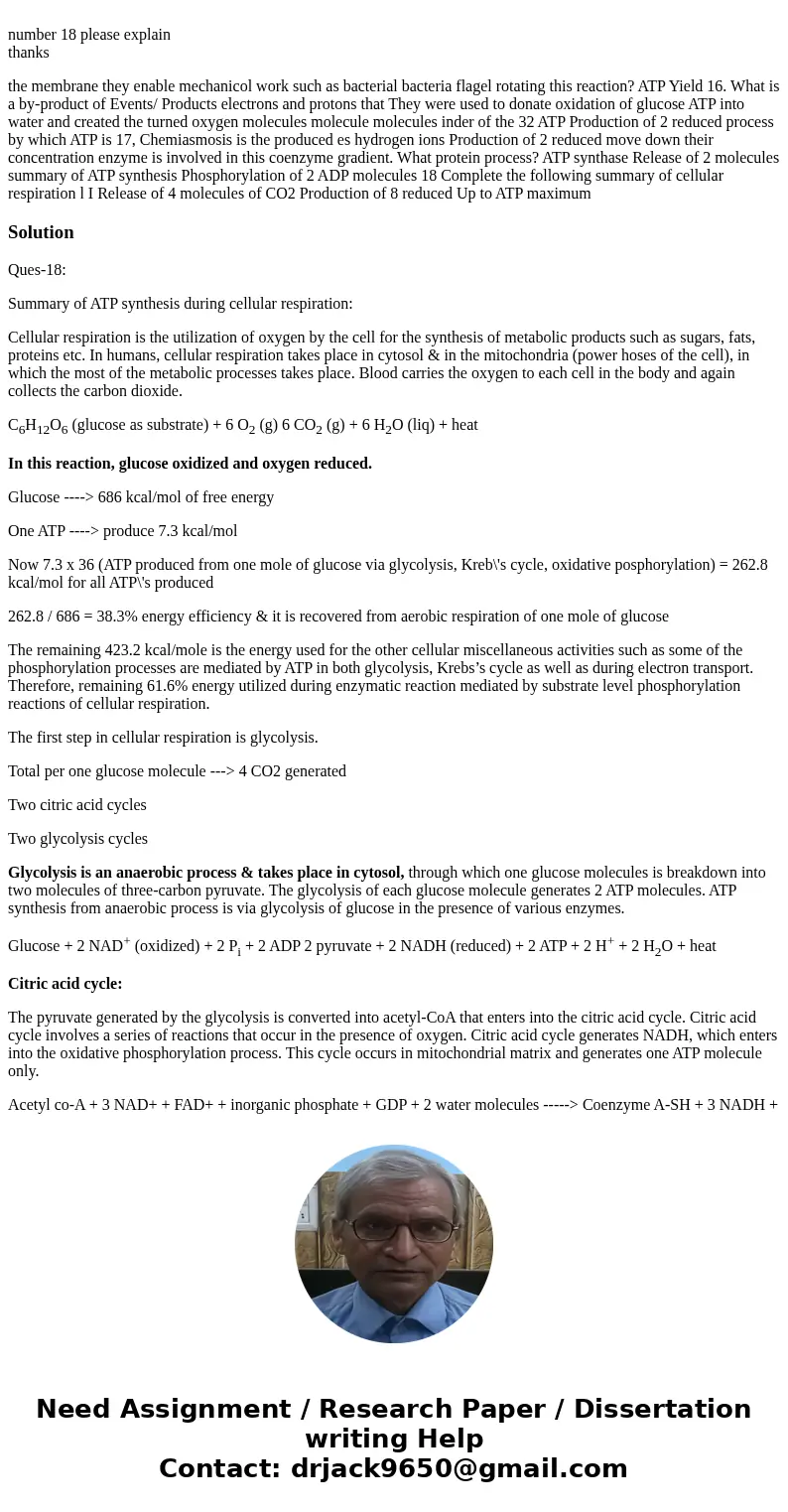
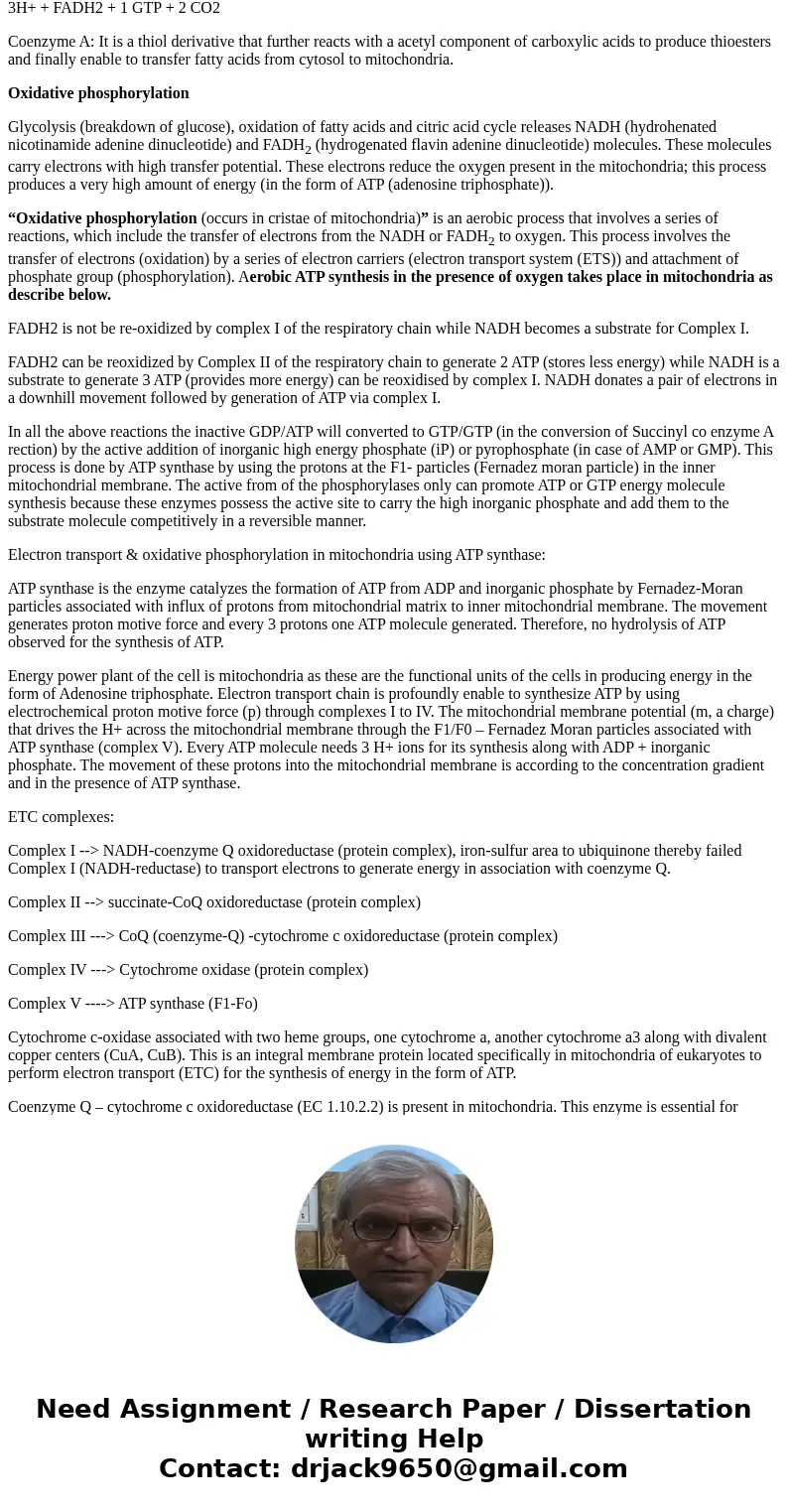
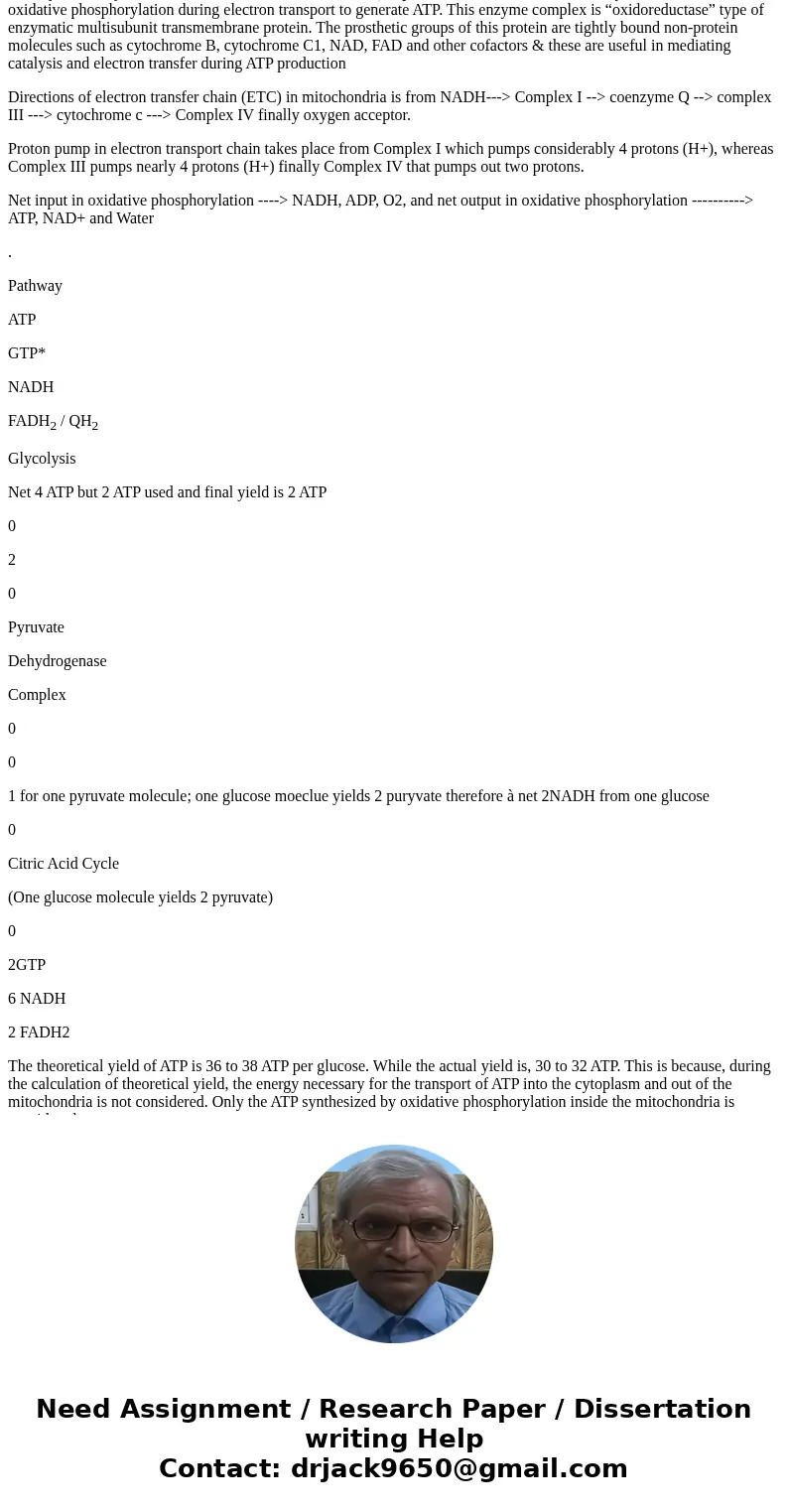
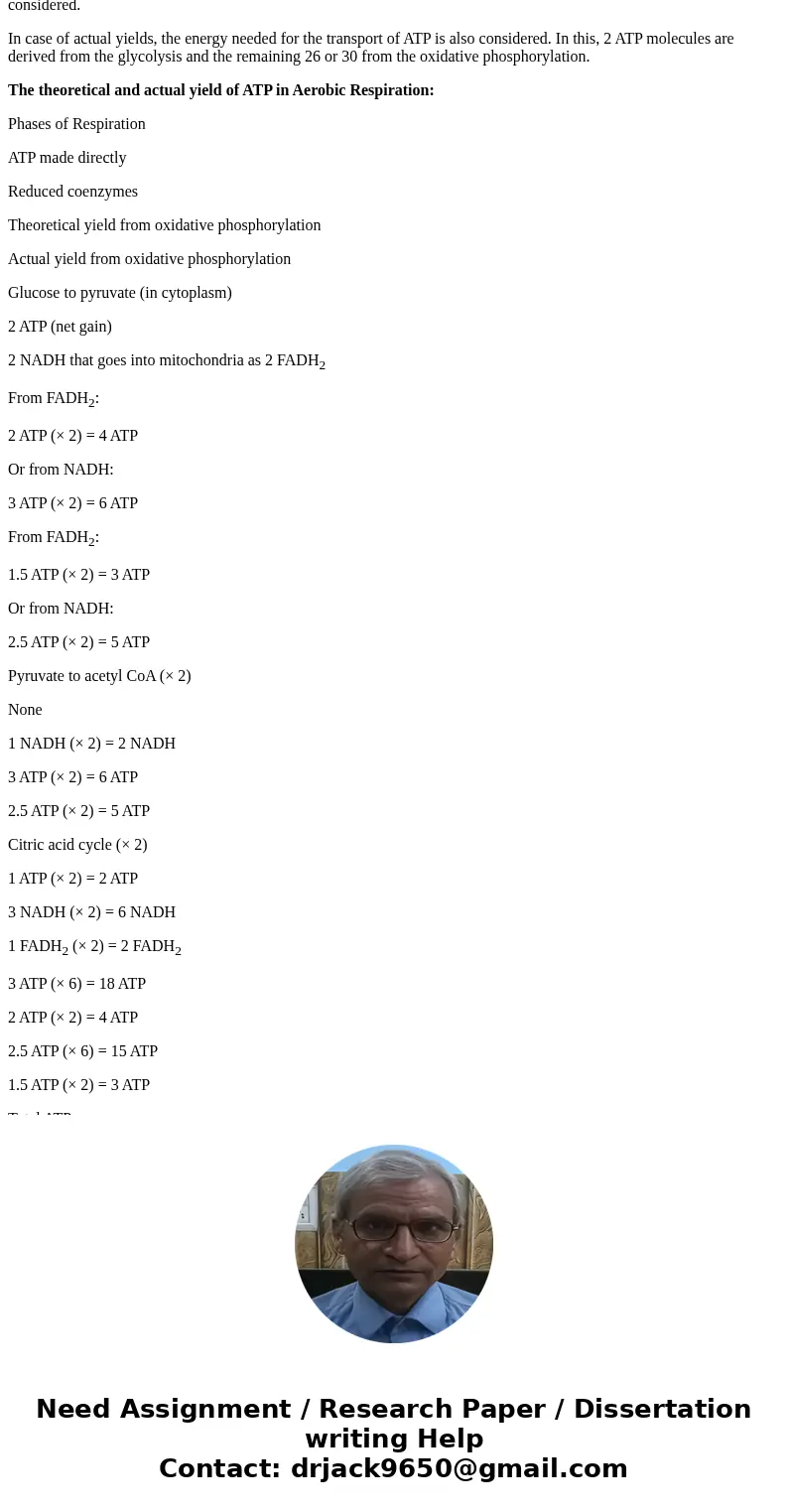
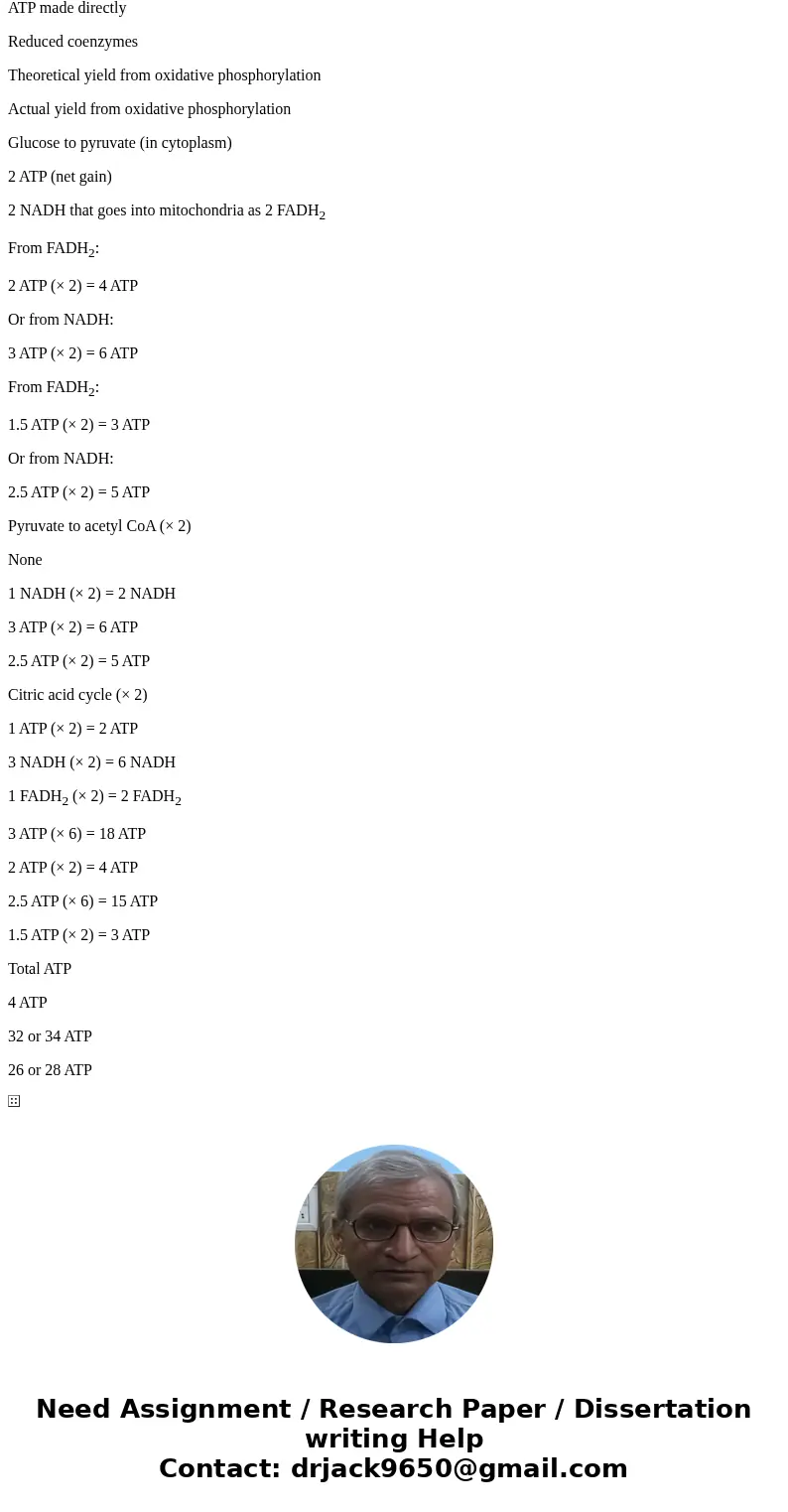
 Homework Sourse
Homework Sourse